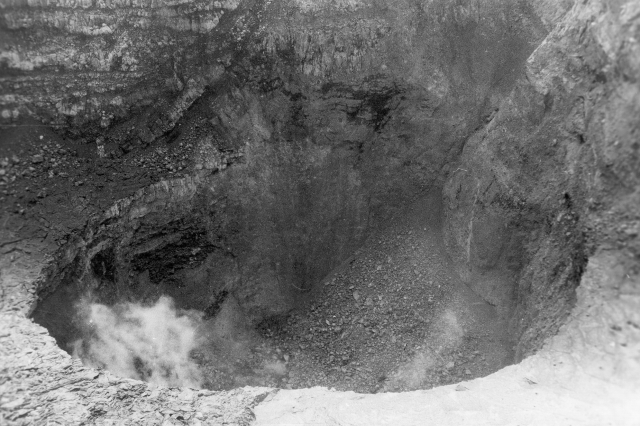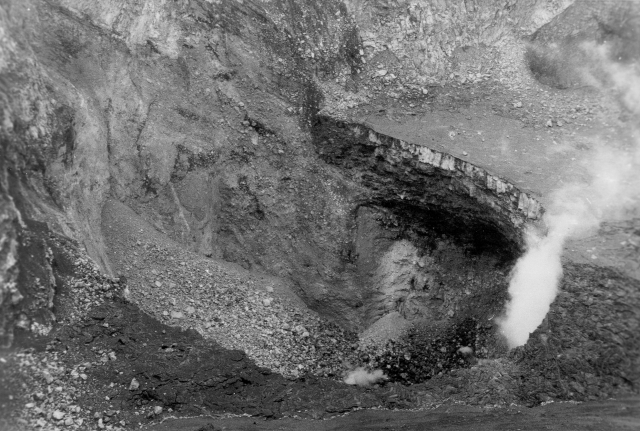Report on Masaya (Nicaragua) — May 1987
Scientific Event Alert Network Bulletin, vol. 12, no. 5 (May 1987)
Managing Editor: Lindsay McClelland.
Masaya (Nicaragua) Collapse and small eruptions from inner crater
Please cite this report as:
Global Volcanism Program, 1987. Report on Masaya (Nicaragua) (McClelland, L., ed.). Scientific Event Alert Network Bulletin, 12:5. Smithsonian Institution. https://doi.org/10.5479/si.GVP.SEAN198705-344100
Masaya
Nicaragua
11.9844°N, 86.1688°W; summit elev. 594 m
All times are local (unless otherwise noted)
Santiago Crater has been in a very active degassing phase, the 4th in this century, since 1979. Such episodes have previously occurred at intervals of 20-25 years and lasted 4-10 years. Volcanic gases, primarily H2O, SO2, HCl, and CO2, have been emitted. The plain of Pacaya (Crucero), in the direction of predominant gas movement, has been most affected by the quantity of SO2, making raising of crops impossible in the area. Degassing phases and the presence of a lava lake are characteristic of Santiago Crater. It is evident that gases emerge along a fissure system, from faults that strike NW-SE.
The landslides from the walls and interior of Santiago Crater that began 12 November 1986 were facilitated by the descent of the magma column or a pressure change of part of the magma chamber below the volcano. The existence of a fracture zone in the crater also facilitated the breakup of its walls. These events were not preceded or accompanied by tremors. The landslide debris partly plugged the gas conduits, although during the next few days a successive resumption of degassing was observed. Thus, sudden transport of gases was expected to lead to a small eruption.
On 18 December 1986 there was a small collapse within the inner crater floor (figures 3 and 4), forming a circular hole and permitting a major flow of gases. No significant changes were observed in January and the beginning of February. On 15 February at 0020 a small eruption occurred in the circular hole. The pressure of lava erupted ash and blocks, the blocks falling back into the bottom of the vent.
 |
Figure 3. Photograph of Santiago's inner crater at Masaya, taken after the collapse events of late 1986 and early 1987. Courtesy of Douglas Fajardo. |
 |
Figure 4. Another photograph of Santiago's inner crater at Masaya, taken after the collapse events of late 1986 and early 1987. Courtesy of Douglas Fajardo. |
On 20 February, a new hole, also in the bottom of the inner crater, formed by collapse, expelling a larger quantity of gases than from the circular vent. The gas column was persistent, rising above the rim of Santiago Crater. The gas that emerged from the new vent was darker because of its higher content of magmatic gases.
A larger increase in gases has been reported since 22 February. The circular vent continued to produce small eruptions. After each eruption, the vent was completely clear, without gases. At the beginning of April, incandescence began to be noted at night.
The inner crater is 180 m in diameter and 72 m deep.
Geological Summary. Masaya volcano in Nicaragua has erupted frequently since the time of the Spanish Conquistadors, when an active lava lake prompted attempts to extract the volcano's molten "gold" until it was found to be basalt rock upon cooling. It lies within the massive Pleistocene Las Sierras caldera and is itself a broad, 6 x 11 km basaltic caldera with steep-sided walls up to 300 m high. The caldera is filled on its NW end by more than a dozen vents that erupted along a circular, 4-km-diameter fracture system. The Nindirí and Masaya cones, the source of observed eruptions, were constructed at the southern end of the fracture system and contain multiple summit craters, including the currently active Santiago crater. A major basaltic Plinian tephra erupted from Masaya about 6,500 years ago. Recent lava flows cover much of the caldera floor and there is a lake at the far eastern end. A lava flow from the 1670 eruption overtopped the north caldera rim. Periods of long-term vigorous gas emission at roughly quarter-century intervals have caused health hazards and crop damage.
Information Contacts: Douglas Fajardo B. and Petr Hradecky, INETER.

